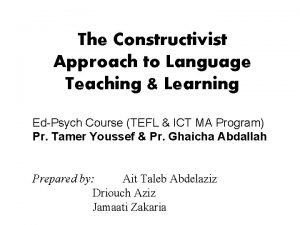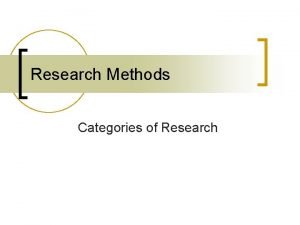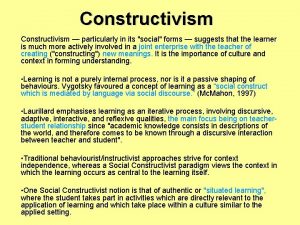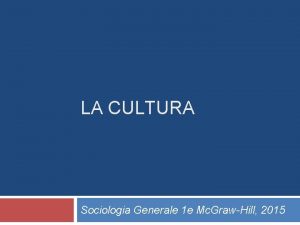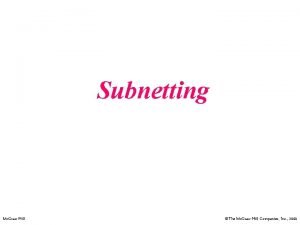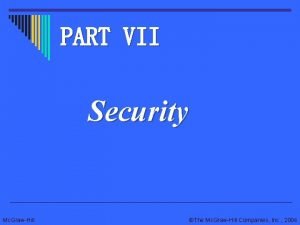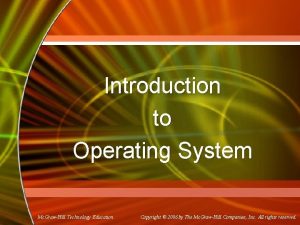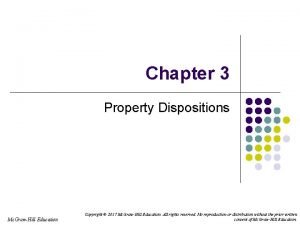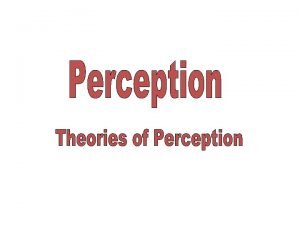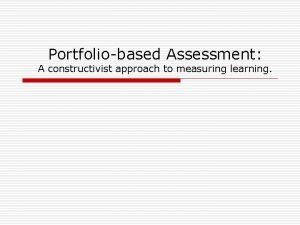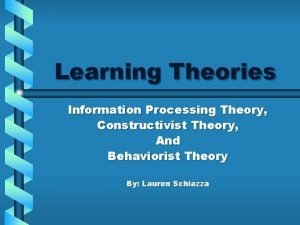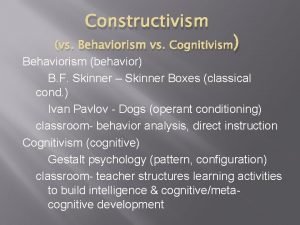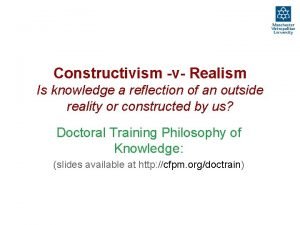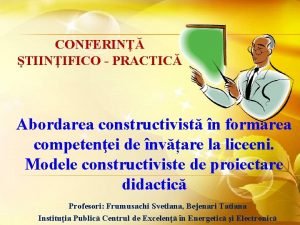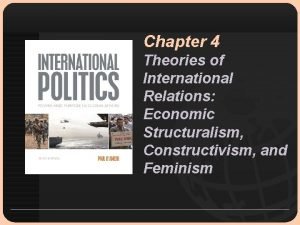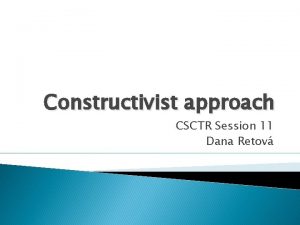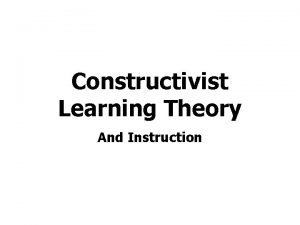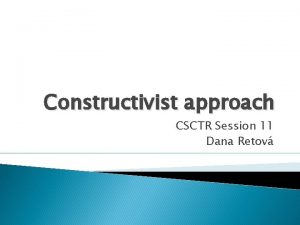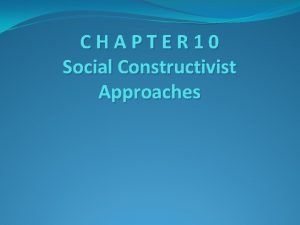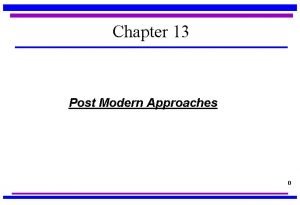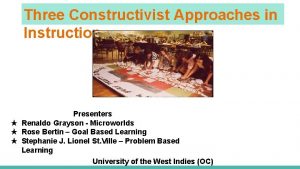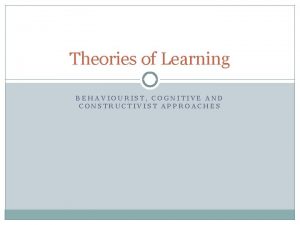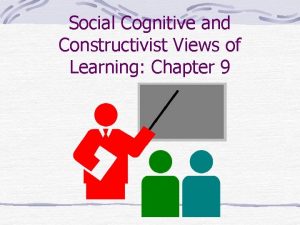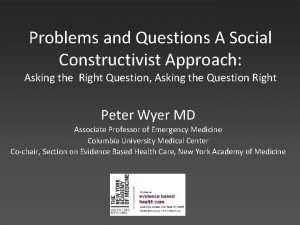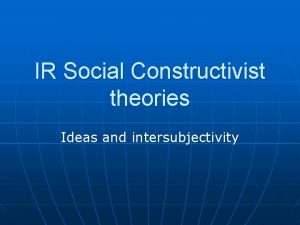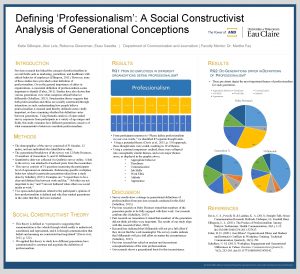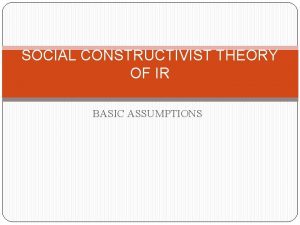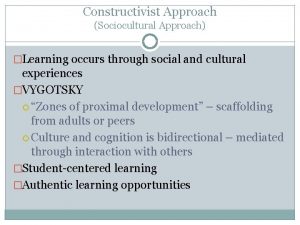CHAPTER 10 Social Constructivist Approaches 2009 Mc GrawHill





















- Slides: 21

CHAPTER 10 Social Constructivist Approaches © 2009 Mc. Graw-Hill Higher Education. All rights reserved.

Learning Goals 1. Compare the social constructivist approach to other constructivist approaches. 2. Explain how teachers and peers can jointly contribute to children’s learning. 3. Make effective decisions in structuring small-group work. 4. Describe two social constructivist programs. © 2009 Mc. Graw-Hill Higher Education. All rights reserved.

Social Constructivist Approaches to Teaching Social Constructivism in the Broader Constructivist Context Situated Cognition © 2009 Mc. Graw-Hill Higher Education. All rights reserved.

Constructivist vs. Social Constructivist Approaches to Teaching Constructivism emphasizes how individuals actively construct knowledge and understanding. Social constructivist approaches emphasize the social contexts of learning, and that knowledge is mutually built and constructed. © 2009 Mc. Graw-Hill Higher Education. All rights reserved.

Situated Cognition …refers to the idea that thinking is “situated” in social and physical contexts, not within an individual’s mind. © 2009 Mc. Graw-Hill Higher Education. All rights reserved.

Social Constructivist Approaches Teachers and Peers as Joint Contributors to Students’ Learning Cooperative Learning Scaffolding Cognitive Apprenticeship Tutoring © 2009 Mc. Graw-Hill Higher Education. All rights reserved.

Teachers and Peers as Joint Contributors to Students’ Learning Cognitive Apprenticeship: An expert stretches and supports the novice’s understanding and use of cultural skills. Scaffolding: Changing the level of support over the course of a teaching session. Tutoring: Includes peers, classroom aides, volunteers, and mentors. Cooperative Learning: Students work in small groups to help each other. © 2009 Mc. Graw-Hill Higher Education. All rights reserved.

Strategies for Using Peer Tutoring n n Use cross-age rather than same-age tutoring when possible Let students participate as tutor and tutee roles Don’t let tutors give tutees tests Don’t overuse peer tutoring © 2009 Mc. Graw-Hill Higher Education. All rights reserved.

Enter the Debate Should teachers use high-ability students to tutor their struggling students? YES NO © 2009 Mc. Graw-Hill Higher Education. All rights reserved.

Cooperative Learning Research (Slavin, 1995) Cooperative learning can improve student achievement when: ¡ ¡ Group rewards are generated, and Individuals are held accountable. © 2009 Mc. Graw-Hill Higher Education. All rights reserved.

Cooperative Learning Approaches © 2009 Mc. Graw-Hill Higher Education. All rights reserved.

Cooperative Learning Approaches © 2009 Mc. Graw-Hill Higher Education. All rights reserved.

Cooperative Learning Approaches © 2009 Mc. Graw-Hill Higher Education. All rights reserved.

Creating a Cooperative Community n n n Class cooperation Interclass cooperation School-wide cooperation School-parent cooperation School-neighborhood cooperation © 2009 Mc. Graw-Hill Higher Education. All rights reserved.

Social Constructivist Approaches Structuring Small. Group Work Structuring Small. Group Interaction Composing the Group Team-Building Skills © 2009 Mc. Graw-Hill Higher Education. All rights reserved.

Structuring Small-Group Work n n n Composing the Group: Heterogeneous groups work. Caution should be used so that average-ability students don’t get lost as highand low-ability students form relationships like those between student and teacher. Team-Building Skills: Help students become better listeners. Give students practice contributing to a team product. Discuss the value of team leaders. Structuring Group Interaction: Assigning students to specific roles within the group gives all members a sense of importance. © 2009 Mc. Graw-Hill Higher Education. All rights reserved.

Social Constructivist Programs Fostering a Community of Learners Schools for Thought © 2009 Mc. Graw-Hill Higher Education. All rights reserved.

Fostering a Community of Learners (Browne, 1997; Campione, 2001) Focus: Literacy Development and Biology Program Emphasis 1. Uses adults as role models 2. Children teaching children 3. Online computer consultation This approach fosters a culture of learning, caring, sharing, and the production of work that is shared with others. © 2009 Mc. Graw-Hill Higher Education. All rights reserved.

Schools for Thought (Lamon et al. , 1996) Curriculum: In-depth, cross-disciplinary inquiry into real-world problems. Instruction: Collaborative, self-directed, exploratory learning. Community: Learning and problem-solving for the betterment of communities. Technology: Communicate electronically with a community of learner’s beyond the classroom. Assessment: Authentic performances, assessment aligned with learning and instruction, selfassessment. © 2009 Mc. Graw-Hill Higher Education. All rights reserved.

Crack the Case The Social Constructivist Classroom 1. 2. 3. 4. What are the issues in this case? What do you think Mariana did incorrectly? What should she do now to recover her constructivist classroom? How can she elicit the cooperation of the parents? © 2009 Mc. Graw-Hill Higher Education. All rights reserved.

Reflection & Observation Reflection: n Think about your educational experiences with group work. What worked well? What did not work well? Why or why not? © 2009 Mc. Graw-Hill Higher Education. All rights reserved.
 Constructive tools examples
Constructive tools examples Social constructivist meaning
Social constructivist meaning Constructivism slideshare
Constructivism slideshare Social constructivist meaning
Social constructivist meaning Grawhill
Grawhill Grawhill
Grawhill 作業管理精簡版13版解答
作業管理精簡版13版解答 Grawhill
Grawhill Mc grawhill
Mc grawhill Mc grawhill
Mc grawhill Grawhill
Grawhill Mc grawhill
Mc grawhill Grawhill
Grawhill Gregory's constructivist theory of perception
Gregory's constructivist theory of perception Constructivist assessment examples
Constructivist assessment examples Modern architecture trends
Modern architecture trends Constructivist theory
Constructivist theory Behaviorist vs constructivist
Behaviorist vs constructivist Constructivism vs realism
Constructivism vs realism Dascal constructivist
Dascal constructivist Economic structuralism definition international relations
Economic structuralism definition international relations Jonassen constructivist learning environment
Jonassen constructivist learning environment
